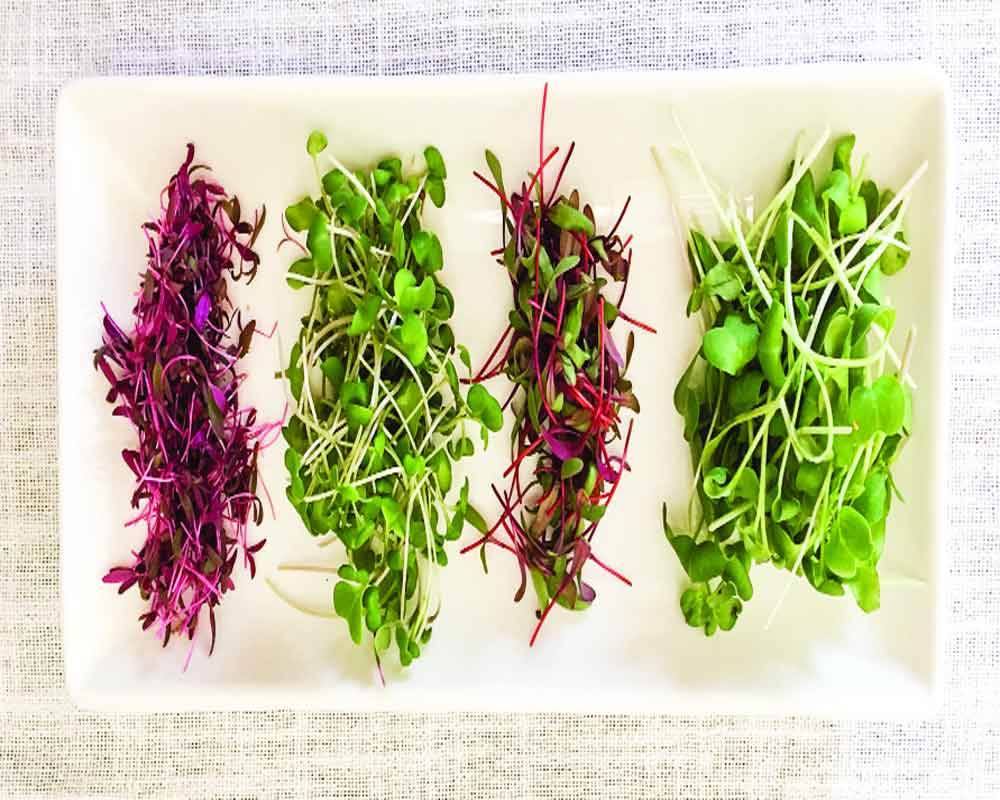During a time when the focus has shifted to eating healthy, here is a way to up your immunity with small things. By Priyanka Joshi Karnatak
The pandemic turned our focus around and made us concentrate on tiny things that improve our health. Microgreens are one food group gradually climbing the charts of popularity. It might have started as an exotic garnish but now, it has made it to the front row of immunity-building foods. You might have seen microgreens in fancy restaurants all around the world. Top chefs have taken a fancy to these because of their ability to enhance the looks, taste and health quotient of dishes.
Delhi-based Swati Jain, The First Leaf, highlighting their importance, says, “A healthy immune system is our best defense against viruses, bacteria and carcinogens. A great way to strengthen it is by adding microgreens to our daily diet. They are abundant in vitamins and minerals that improve the body’s ability to fight, prevent and recover from an illness.”
But what are microgreens and where can we find these? You know that a bunch of fenugreek (methi) is a great source of vitamins, minerals and so much more. Similarly, mustard greens are loaded with antioxidants and essential vitamins. Then, there is spinach that’s packed with plenty of minerals and iron. In fact, the list of these amazingly nutritious vegetables is rather long.
“Now imagine, if we could harness up to 40 or even 50 times the nutrients out of these already magical vegetables. The small edible greens grown from the seeds of these mighty vegetables are called microgreens,” says Jain and adds, “Always make sure that these are grown organically and consumed as living foods.”
Microgreens are the first true leaves produced from a seedling of vegetables and herbs that are about two-three inches tall. There are so many varieties of plants including turnips, radishes, broccoli, cauliflower, carrots, celery, chard, lettuce, spinach, arugula, amaranth, cabbage, beets, parsley and basil, to name a few, that can be
grown as microgreens for a wholesome and nutritious addition to your daily meals. The tiny leaves of most of the microgreens get ready for harvest in 12 to 14 days and are packed with nutrition and intense flavours imitating their mature counterparts.
Bengaluru-based chef Vikram Udaygiri and his wife Divya Kumar from Earthistic Agro represent the Ministry of External Affairs in promoting Indian cuisine and have organised food festivals in several countries including South Africa, Israel, and Egypt. “During a food festival in Zimbabwe, I came across microgreens being used as a garnish for dishes in the same way that we use coriander or curry leaves. I was amazed because, at the time, these tiny leaves were considered an exotic ingredient back home and were also quite expensive. I wondered if I could work towards changing that perception and make them affordable,” says chef Udaygiri. The couple, in 2017, converted his grandparents’ empty house into a microgreens farm and today he is one of the top suppliers in Bengaluru. He adds, “We have door-to-door delivery because now people are aware and concerned about their health. And trust me, it’s a very good source for improving immunity.”
Fine dining has relied on the power of microgreens for some time now. Chef Siddharth Sharma, Holiday Inn New Delhi Mayur Vihar Noida says, “For a long time microgreens were used and served as a decorative item and for colour contrast, especially in Continental and French food. These give a different texture and elevate the flavours of food.”
But if you think these are best used in a restaurant, you are mistaken. These tiny greens can improve the flavours of your regular, homemade food to something par excellence. Jain says, “These can work as a great healthy addition to our daily diet. These are not only packed with nutrition but a lot of flavour too. Basil, corn shoots, amaranth, sunflower, pakchoi, pea shoots have a mild flavour profile. Whereas mustard, radish, arugula, garden cress have a sharper flavour. One can pick and choose based on his/her palate.” Another advantage is their versatility. You can blend them in smoothies, stuff them in sandwiches, toss them in salads, sprinkle them over eggs. Or simply munch on them like a snack.
Dr Manjari Chandra says that there is more which works in the favour of adding microgreens to your diet. She says, “Most of our food has pesticides and growing these at home can be the first step towards a healthy life. These plants stimulate immunity, help to lose weight and reduce inflammation. They contain sulphur that repairs damaged cells in our bodies. These tiny plants are a kitchen pharmacy.”
So, what are you waiting for? Go ahead and get that dash of micro.


























